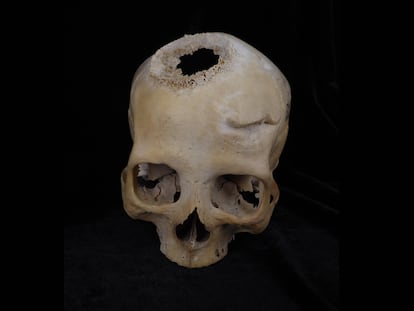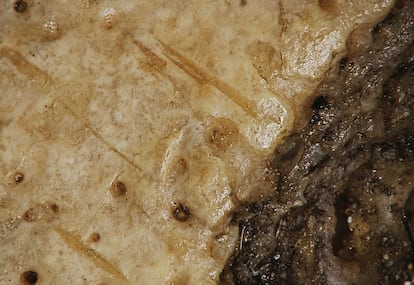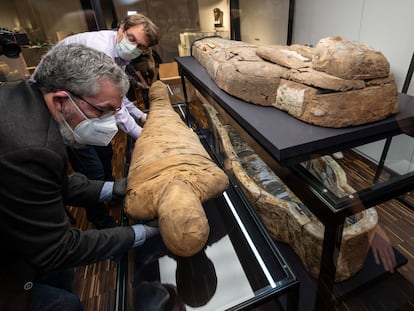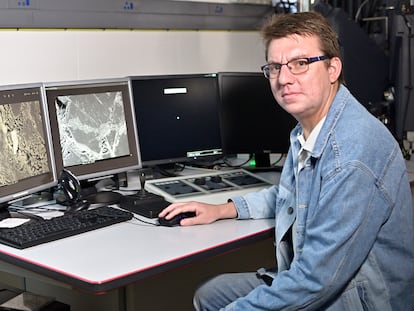Researchers discover evidence of cancer surgery in skull from Ancient Egypt
Spanish scientists have found the oldest case of oncological intervention in remains dating back 4,000 years, when the Egyptian civilization was flourishing

In October 2022, Spanish archaeologist Edgard Camarós found a cardboard box on which someone had written: “cancer?” Inside was a pile of bones from thousands of years ago. It was part of the Duckworth collection at the University of Cambridge, one of the largest repositories of ancient human remains in the world. Two skulls with chilling scars were in the box. “The annotations on the boxes said that they came from Giza, in Egypt, where the pyramids are,” explains Camarós, who is now at the University of Santiago de Compostela in Spain. “These remains come from English colonialist archeology, in which they went and took the most curious or striking things. We do not know if these two skulls were in the necropolis, probably they were. Due to the health of the teeth and the treatment they received in life, they were possibly people from a good social position,” says the archaeologist.
Together with Tatiana Tondini, from the University of Tübingen in Germany, and Albert Isidro, from the Autonomous University of Barcelona, Camarós has used microscopy and three-dimensional scanning techniques to analyze the bones and their injuries in detail. The researchers have concluded that they are two of the oldest known cases of cancer. One of them also provides the first evidence of oncological surgery, a rudimentary attempt to try to remove the tumor. The results have been published in the journal Frontiers in Medicine.
The oldest skull was from a male who lived more than 4,000 years ago (between 2687 and 2345 B.C.), the time when the first Egyptian dynasties flourished and the great pyramids were built. Researchers believe the marks on the skull are from a metastasis that spread from a primary tumor in the pharynx that had also affected the palate. What’s most interesting is that, around the head tumors, the microscope reveals cut marks likely made with a scalpel in an attempt to remove the tumor. The fact that it did not heal indicates the effort was of little use, and the individual died shortly before or shortly after the operation.
For Camarós, these small marks mean much more than it seems. If the patient was alive, we would be looking at the first known oncological surgery. If it happened after death, it is evidence of an autopsy that was probably performed to try to better understand a disease that, in those times, was a “frontier into the unknown, despite how advanced Egyptian medicine was,” he explains.
So far, mummies have been found with a multitude of medical interventions: trepanations, prostheses, healed fractures, even dental fillings. In addition to masterfully mummifying corpses, the Egyptians wrote the first known medical treatise 4,500 years ago. In it, the physician Imhotep describes almost 50 clinical cases and their possible treatments. One of them is a woman with a breast tumor. The physician describes in detail the appearance and texture of the tumor to the touch, but despite all his knowledge, he recognizes that there is no known cure for this disease.

The second skull is more recent, from about 2,700 years ago, and has a terrible wound, as if something had devoured the skull or it had exploded. The remains are from a 50-year-old woman who suffered a deep head injury above her left eyebrow. It was probably inflicted by a right-handed attacker with a sword or other sharp blade. “If it had been a man, we would have immediately said it was a warrior. Being a woman [and given the researchers only have her skull] it is a bit more complex, although it might raise the question that the role of women could be different from what we thought,” Camarós ventures. Despite the fact that the Egyptians did not know any cure for the frequent infections, the woman was cured of her wound, perhaps thanks to the care of doctors. Then a tumor appeared on the back of the skull that scientists identify as an osteosarcoma or a meningioma. This was a disease the doctors could not cure.
Today, neither of these two patients would have developed such advanced tumors, and they would probably have been cured, Camarós believes. The remains provide new data on the evolution of cancer and how it has changed over time. “Cancer is a product of our habits and our genetics and is very different today from the cancer suffered, for example, by chimney sweepers in England in the 18th century. Interestingly, nasopharyngeal tumor is one of those with the highest evidence in Egypt. And that possibly has to do with a desert-type environment where inhaling sand perhaps inflames the nasal cavities and is a factor that could increase the incidence of this tumor at that time,” he points out.
In 2017, forensic anthropologist Miguel Botella, from the University of Granada in Spain, diagnosed the oldest known case of breast cancer, that of a woman in her 40s whose cancer had spread throughout her body, causing terrible suffering. Botella highlights the importance of the new discovery and reflects on its significance. “Perhaps the most interesting thing is that there was care for these people,” he says. “The fact that someone reached this point — operating on the skull, although the disease was already widespread — speaks to us of an environment of important care and resources, as well as a cultural interest in understanding a disease that is inherent to humans and living beings in general,” he says.
Luis Alfaro, from the Spanish Society of Pathological Anatomy, offers a critical opinion that illustrates how difficult it is to make a consensus diagnosis when it comes to patients who died more than 2,000 years ago. “The case of the woman, at 50 years old, could hardly be osteosarcoma. At her age, it would be a rarity. And a meningioma would grow from the inside out, but the lesion is much larger on the outside than on the inside. I think cutaneous carcinomas would be more likely: squamous cell or basal cell carcinomas, which, if left to evolve, can cause extensive bone destruction,” he points out. “The other case, with an estimated age of 30 years or younger, makes the diagnosis of metastatic carcinoma difficult. It is true that nasopharyngeal carcinomas occur at younger ages than other types and can cause bone metastases, but they are rare in the skull. I would take into consideration a possible polyostotic fibrous dysplasia, a benign entity but with significant craniofacial bone lesions.” “In any case,” he adds, “it is a rigorous study with spectacular images.”
Sign up for our weekly newsletter to get more English-language news coverage from EL PAÍS USA Edition
Tu suscripción se está usando en otro dispositivo
¿Quieres añadir otro usuario a tu suscripción?
Si continúas leyendo en este dispositivo, no se podrá leer en el otro.
FlechaTu suscripción se está usando en otro dispositivo y solo puedes acceder a EL PAÍS desde un dispositivo a la vez.
Si quieres compartir tu cuenta, cambia tu suscripción a la modalidad Premium, así podrás añadir otro usuario. Cada uno accederá con su propia cuenta de email, lo que os permitirá personalizar vuestra experiencia en EL PAÍS.
¿Tienes una suscripción de empresa? Accede aquí para contratar más cuentas.
En el caso de no saber quién está usando tu cuenta, te recomendamos cambiar tu contraseña aquí.
Si decides continuar compartiendo tu cuenta, este mensaje se mostrará en tu dispositivo y en el de la otra persona que está usando tu cuenta de forma indefinida, afectando a tu experiencia de lectura. Puedes consultar aquí los términos y condiciones de la suscripción digital.
More information
Archived In
Últimas noticias
Most viewed
- Sinaloa Cartel war is taking its toll on Los Chapitos
- Oona Chaplin: ‘I told James Cameron that I was living in a treehouse and starting a permaculture project with a friend’
- Reinhard Genzel, Nobel laureate in physics: ‘One-minute videos will never give you the truth’
- Why the price of coffee has skyrocketed: from Brazilian plantations to specialty coffee houses
- Silver prices are going crazy: This is what’s fueling the rally











































